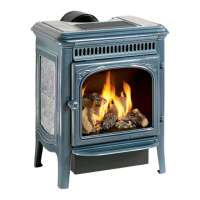Venting/Chimney Requirements 8
Normally Aspirating Chimneys
The Tucson is a highly efficient gas heater. With
operating efficiency as high as 82%, most heat
output is retained within the living space, with
minimal heat leaving the room via the chimney.
However , some heat is required in all chimneys in
order to establish and maintain a draft. Since most
of the heat is retained in the living space with
minimal heat entering the chimney, it is imperative
that the chimney/venting system be properly sized
and installed in order to establish and maintain the
draft required for the unit to function.
The Tucson must be properly connected to a 4"
(102 mm) diameter type B-1 vent which is
constructed and installed in accordance with
NFPA54 and NFPA211. Single wall vent pipe
may be used within the same room as the Tucson
so long as adequate (6" or 152 mm) clearance is
maintained from the single wall pipe to
combustible surfaces. The single wall vent pipe
must connect to double-wall type B-1 vent from
thereon. The minimum clearance from type B-1
vent to combustibles is 1"(25 mm).
Connect the single wall or B-1 vent pipe to the
flue collar located on the rear surface of the unit
using 3 sheet metal screws. For wall, roof or
partition penetration, refer to the current edition of
ANSI Z223.1 or CAN1-B149 for instructions
and clearances to combustibles. The Tucson can
be connected to an existing, properly constructed
masonry or prefabricated chimney so long as the
type B-1 vent is extended through the entire length
of the chimney. An annual inspection is required to
confirm that the vent is unobstructed. The vent can
not be connected with a flue serving a solid fuel
appliance. It however, can be installed to a flue
serving another gas or oil appliance, so long as it
is in accordance with the National Fuel Gas Code.
Type B-1 vent pipe is intended primarily for
installation inside buildings to provide an
essentially
vertical passageway for flue gases from the
vented gas appliance to the outside air. When it
is impractical to install B-1 vent pipe inside a
building, it may be installed outdoors provided
that it is: 1) certified for outside installation, 2)
installed in accordance with manufacturer’s
installation instructions and 3) adequately chased
(enclosed) and insulated (per Venting Tables,
Category I-Central Furnaces, AGA and
GAMA current edition; Standards for Gas
Vents, National Standards of Canada and
CAN/CGA-B149.1-M91). Exterior B-1 vent
pipe passing through an unused masonry
chimney flue is not considered to be exposed to
the outdoors.
Four inch flexible pipe can be used in place of
B-1 vent pipe wherever it is impractical or
impossible to install rigid Type B-1 vent pipe.
However, flexible pipe is less desirable than B-1
vent pipe, because there is a greater heat loss
along the length of flex pipe which may produce
an unacceptable draft.
Draft Hood/Down Draft Sensor/Spill
Switch
The Tucson has a draft hood as part of its rear
assembly. The draft hood must not be altered
or obstructed. The Tucson must be installed so
that the draft hood is in the same atmospheric
pressure zone as the combustible air inlet for the
unit. The Tucson cannot and must not be
connected to an outside air source; the unit must
take its combustion air from the living space in
which it is installed.

